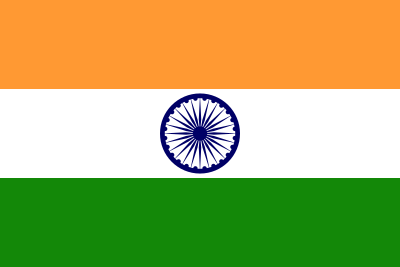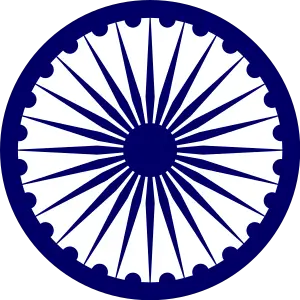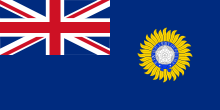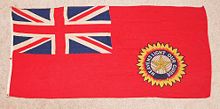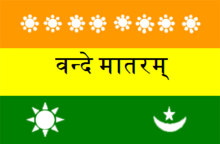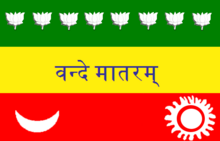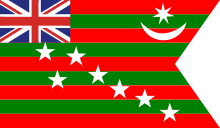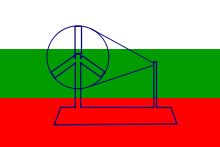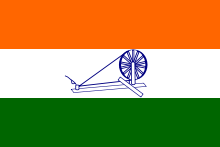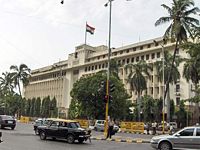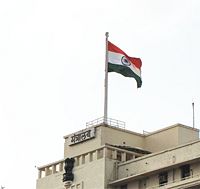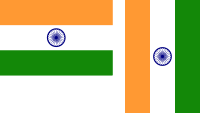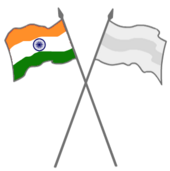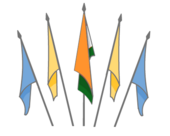Flag of India
An ad hoc meeting of the Constituent Assembly, held on the July 22, 1947, adopted the National Flag of India, in its present form, a few days before India's independence from the British on August 15, 1947. The flag served as the national flag of the Dominion of India between August 15, 1947 and January 26, 1950 and that of the Republic of India thereafter. In India, the term "tricolour" [TirangÄ â तिरà¤à¤à¤¾ (in Hindi)] almost always refers to the Indian national flag.
The flag displays a horizontal tricolour of "deep saffron" at the top, white in the middle, and green at the bottom. In the center, a navy blue wheel with twenty-four spokes, known as the Ashoka Chakra, had been taken from the Lion Capital of Asoka erected atop Ashoka pillar at Sarnath. The diameter of that Chakra spans three-fourths of the height of the white strip. The ratio of the width of the flag to its length measures 2:3. The Indian Army uses the flag as its war flag, hoisted daily on military installations.
| This article contains Indic text. Without proper rendering support, you may see question marks or boxes, misplaced vowels or missing conjuncts instead of Indic text. |
The actual color used in the top band in all depictions of the flagâincluding this pageâ has been either blaze orange or pumpkin rather either than saffron or deeper shades of saffron like goldenrod or dark goldenrod. Pingali Venkayya designed the Indian National Flag. The official flag specifications require that the flag be made only of "khadi," a special type of hand-spun yarn. The Indian Flag Code strictly defines the display and use of the flag. A heraldic description of the flag would be Party per fess Saffron and Vert on a fess Argent a "Chakra" Azure.
The story of the development of the flag of India is the story of India gaining independence from British Rule and establishing a nation among people with differing, fervent religious beliefs. The rift between Muslim and Hindu led to the partition of Pakistan and the creation of an Islamic state. India, even after the partition of Pakistan, remained committed to including the Muslim in the national fabric of India. The final version of the flag of India demonstrates national unity among religious faiths through spirituality, truth, and justice.
Design
The following approximate the colors of the Indian flag in different color models, sorted into the HTML RGB Web colors (hexadecimal notation); the CMYK equivalent; dye colors and the Pantone equivalent number.[1]
| Scheme | Web Color | HTML | CMYK | Textile color | Pantone |
|---|---|---|---|---|---|
| Saffron | #FF9933 | 0-50-90-0 | Saffron | 1495c | |
| White | #FFFFFF | 0-0-0-0 | Cool Grey | 1c | |
| Green | #138808 | 100-0-70-30 | India green | 362c | |
| Navy blue | #000080 | 100-98-26-48 | Navy blue | 2755c |
The official (CYMK) value of the top band calculates (0,50,90,0)âclosest to the color pumpkinâwith CYMK = (0,54,90,0); the CYMK value of true saffron and deep saffron (goldenrod) being (4, 23, 81, 5) and (0, 24, 85, 15) respectively.[1]
Symbolism
A few days before India became independent on August 1947, the specially constituted Constituent Assembly decided that the flag of India must be acceptable to all parties and communities.[1] They selected a flag with three colors, Saffron, White and Green with the Ashoka Chakra. Sarvepalli Radhakrishnan, who later became India's first Vice President, clarified the adopted flag and described its significance as follows:
Bhagwa or the saffron color denotes renunciation of disinterestedness. Our leaders must be indifferent to material gains and dedicate themselves to their work. The white in the centre is light, the path of truth to guide our conduct. The green shows our relation to (the) soil, our relation to the plant life here, on which all other life depends. The "Ashoka Chakra" in the centre of the white is the wheel of the law of dharma. Truth or satya, dharma or virtue ought to be the controlling principle of those who work under this flag. Again, the wheel denotes motion. There is death in stagnation. There is life in movement. India should no more resist change, it must move and go forward. The wheel represents the dynamism of a peaceful change.[2]
A widely held, unofficial interpretation, explains that the saffron stands for purity and spirituality, white for peace and truth, green for fertility and prosperity and the wheel for justice.
History
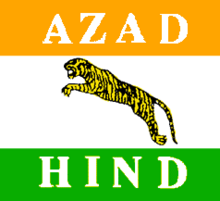
At the beginning of the twentieth century, as the Indian independence movement seeking freedom from British colonial rule gained ground, Indian patriots felt the need for a national flag that would serve as a powerful symbol of these aspirations. In 1904, Sister Nivedita, an Irish disciple of Swami Vivekananda, came up with the first flag of India, later referred to as Sister Nivedita's Flag. A red square-shaped flag with a yellow inset, the flag depicted a "Vajra Chinha" (thunderbolt) with a white lotus alongside it in the center. Designers inscribed the words "বনà§à¦¦à§ মাতরম" (Bônde Matorom meaning "Mother[land], I bow to thee!") on the flag in Bengali. The red color signified the freedom struggle, yellow signified victory, and the white lotus signified purity.[1]
The first tricolour unfurled on August 7, 1906, during a protest rally against the Partition of Bengal, by Schindra Prasad Bose in Parsi Bagan Square in Calcutta. That flag came to be known as the Calcutta Flag. The flag had three horizontal bands of equal width with the top being orange, the centre yellow and the bottom green in color. It had eight half-opened lotus flowers on the top stripe, and a picture of the sun and a crescent moon on the bottom stripe with the words Vande Mataram inscribed in the center in the Devanagari script.[3]
On August 22, 1907, Bhikaiji Cama unfurled another tricolour flag in Stuttgart, Germany. That flag had green at the top, saffron in the center and red at the bottom, the green standing for Islam and the saffron for both Hinduism and Buddhism. The flag had eight lotuses in a line on the green band representing the eight provinces of British India. The words Vande Mataram, in the Devanagari script, inscribed the central band. On the lowest band, towards the hoist of the flag, a crescent, and towards the fly, a sun appeared. Bhikaiji Cama, Veer Savarkar and Shyamji Krishna Varma jointly designed the flag.[3] After the outbreak of World War I, that flag became known as the Berlin Committee Flag after the Indian Revolutionaries adopted it at the Berlin Committee. Troops actively used that flag actively in Mesopotamia during the First World War. Patriots also used the Ghadar Party flag in the United States as a symbol for India for a short period of time.
The Home Rule Movement formed by Bal Gangadhar Tilak and Annie Besant in 1917 adopted a new flag, one which featured five red and four green horizontal stripes. On the upper left quadrant, the Union Flag appeared signifying the Dominion status that the movement sought to achieve. A crescent and a star, both in white, display in top fly. Seven white stars show, sacred to Hindus, arranged as in the Saptarishi constellation (the constellation Ursa Major). That flag could not become popular among the masses.[3]
A year earlier in 1916, Pingali Venkayya, from Machilipatnam in present-day Andhra Pradesh tried to devise a common national flag. Umar Sobani and SB Bomanji, who together formed the Indian National Flag Mission, noticed his endeavors. When Venkayya sought Mahatma Gandhi's approval for the flag, the Mahatma suggested the incorporation of the "Charkha" or spinning wheel on the flag, symbolizing "the embodiment of India and the redemption of all its ills." The humble spinning-wheel had become a hallowed symbol of the economic regeneration of India associated with Gandhiâs crusade to make Indians self-reliant by making their clothing from local fibers. Pingali Venkayya came up with a flag with the charkha on a red and green background. Mahatma Gandhi found that the flag failed to represent all the religions of India.[3]
To address Mahatma Gandhi's concerns, another new flag was designed. This tricolour featured white on top, green in the center, and red at the bottom, symbolizing the minority religions, Muslims, and Hindus respectively, with a "Charkha" drawn across all three bands. Patriots drew parallels with the close resemblance to the Flag of Ireland, symbol of the other major freedom struggle against the British Empire.[1] The Congress Party first unfurled that flag at their party meeting in Ahmedabad. Although the flag never became the official flag of the Indian National Congress party, the freedom movement used it widely.
Many felt dissatisfied with the communal interpretation of the flag. The All India Sanskrit Congress that convened in Calcutta in 1924 suggested the inclusion of saffron or ochre and the "gadha" (mace) of Vishnu as the symbol of the Hindus. Later that year, some advanced the suggestion of geru (an earthy-red color) "typified the spirit of renunciation and symbolized an ideal common to the Hindu yogis and sanyasis as well as the Muslim fakirs and darveshes." The Sikhs also stepped up the demand to either include a yellow color that would represent them, or abandon religious symbolism altogether. By 1929, Gandhi himself was offering a new interpretation of the colors of the flag, one that highlighted the supposedly universalist values that each color embodied: red for sacrifice, white for purity, and green for hope.[4]
In light of those developments, the Congress Working Committee appointed a seven member Flag Committee on 1931-04-02 to sort out the issues. A resolution passed noting that "objection has been taken to the three colors in the flag on the ground that they are conceived on the communal basis." A flag featuring just one color, ochre, and a "Charkha" at upper hoist became the unlikely result of those confabulations. Though recommended by the flag committee, the INC rejected that flag, as it seemed to project a communalistic ideology.
Later, the final resolution on a flag passed when the Congress committee met at Karachi in 1931. They adopted the tricolour flag designed by Pingali Venkayya featuring three horizontal strips of saffron, white, and green, with a "Charkha" in the center. They interpreted colors thus: saffron for courage; white for truth and peace; green for faith and prosperity. The "Charkha" symbolized the economic regeneration of India and the industriousness of its people.[1]
At the same time the Indian National Army used a variant of the flag that included the words "Azad Hind" with a springing tiger in lieu of the "Charkha" signifying Subhash Chandra Bose's armed struggle as opposed to Mahatma Gandhi's non-violence. That tricolour hoisted for the first time on Indian soil in Manipur by Subhash Chandra Bose.
A few days before India gained its freedom in August 1947, the Constituent Assembly formed to discuss the flag of the India. They set up an ad hoc committee headed by Rajendra Prasad and consisting of Abul Kalam Azad, Sarojini Naidu, C. Rajagopalachari, KM Munshi and B.R. Ambedkar as its members. The Flag Committee, constituted on June 6, 1947-06-23, began deliberations on the issue. After three weeks they came to a decision on July 14, 1947, being that the flag of the Indian National Congress should be adopted as the National Flag of India with suitable modifications, to make it acceptable to all parties and communities. They further resolved that the flag should not have any communal undertones. They adopted the "Dharma Chakra" which appears on the abacus of Sarnath in the place of the "Charkha." The flag unfurled for the first time as that of an independent country on August 15, 1947.[5]
Manufacturing process
| Size | mm |
|---|---|
| 1 | 6300Â ÃÂ 4200 |
| 2 | 3600Â ÃÂ 2400 |
| 3 | 2700Â ÃÂ 1800 |
| 4 | 1800Â ÃÂ 1200 |
| 5 | 1350Â ÃÂ 900 |
| 6 | 900Â ÃÂ 600 |
| 7 | 450Â ÃÂ 300 |
| 8 | 225Â ÃÂ 150 |
| 9 | 150Â ÃÂ 100 |
After India became a republic in 1950, the Bureau of Indian Standards (BIS) brought out the specifications for the flag for the first time in 1951, revised in 1964 to conform to the metric system adopted in India. They further amended the specifications on August 17, 1968.[6] The specifications cover all the essential requirements of the manufacture of the Indian flag including sizes, dye color, chromatic values, brightness, thread count and hemp cordage.
Only Khadi or hand-spun cloth may be used in the production of the flag, restricted to cotton, silk and wool. Two kinds of khadi used may be used in flag manufacture; the khadi-bunting which makes up the body of the flag and the khadi-duck, a beige-colored cloth that holds the flag to the pole. The khadi-duck constitutes an unconventional type of weave that meshes three threads into a weave as compared to two weaves used in conventional weaving. Weavers rarely use that type of weaving, fewer than a dozen weavers in India professing the skill.[7]
Two handloom units in Dharwad and Bagalkot districts of northern Karnataka provide the woven khadi. Currently, only Karnataka Khadi Gramodyoga Samyukta Sangha, production and supply unit in Hubli, has a license to produce flag. The Khadi Development and Village Industries Commission (KVIC), allotts permission for setting up flag manufacturing units in India, though the BIS has the power to cancel the licenses of units that flout guidelines.[6]
Once woven, the manufacturer sends the material to the BIS laboratories for testing. After stringent quality testing the flag, if approved, returns to the factory, then bleached and dyed into the respective colors. In the center, they screen print, stencil or suitably embroider the Ashoka Chakra. Care also has to be taken that the chakra matches and remains completely visible on both sides. The BIS then checks for the colors and only then can the flag be sold.
Each year, Indians purchase around forty million flags. The government of Maharashtra flies the largest flag in India (6.3Â ÃÂ 4.2Â m) atop the Mantralaya building, the state administrative headquarters.[7]
Proper flag protocol
Prior to 2002, the government prohibited the general public of India from flying their national flag publicly except on designated national holidays. Only government offices and higher functionaries of the government could do so. An industrialist by name Naveen Jindal filed a public interest petition in the Delhi High Court, seeking the striking down of that restriction. When Jindal flew the flag atop his office building, the government confiscated his flag as a violation of the National flag code, informing he of pending litigation. Jindal argued that he had the right as a citizen of India to hoist the National flag with due decorum and honor, as a way of expressing his love for India.[8] The case moved to the Supreme Court of India, which asked the Government of India to set up a committee to consider the matter. The Union Cabinet amended the Indian flag code with effect from January 26, 2002, allowing the general public to hoist the flag on all days of the year, provided they safeguarded the dignity, honor and respect of the flag.
Respect for the flag
Indian law says that the flag must at all times be treated with "dignity, loyalty and respect." The "Flag Code of India â 2002," amended in December 2021, which superseded "The Emblems and Names (Prevention of Improper Use) Act, 1950," governs the display and usage of the flag. Official regulation states that the flag must never touch the ground or water, be used as a tablecloth or draped in front of a platform, cover a statue, plaque, cornerstone etc. Until 2005, the flag could not be used in clothing, uniform or costume. On July 5, 2005, the Government of India amended the code, allowing use of the flag as clothing and uniform, although never below the waist or as undergarments. The law also prohibited embroidering the national flag and other symbols onto pillowcases or neckerchiefs.[9]
The flag may not be intentionally placed upside down, dipped in anything, or hold any objects other than flower petals before unfurling. No sort of lettering may be inscribed on the flag.[6]
Handling of the flag
There are a number of traditional rules of respect that should be observed when handling or displaying the flag. According to the recent revision of the code, the flag may now be flown day and night. The earlier provision stated: âWhere the flag is displayed in the open, the flag should always be hoisted at sunrise and lowered at sunset, irrespective of the weather conditions."[10]
The flag should never be depicted, displayed or flown upside down. Tradition also states that when draped vertically, the flag should not merely be rotated through 90Â degrees, but also reversed. One "reads" a flag like the pages of a book, from top to bottom and from left to right, and after rotation the results should be the same. It is also insulting to display the flag in a frayed or dirty state. The same rule applies to the flagpoles and halyards used to hoist the flag, which should always be in a proper state of maintenance.[2]
Correct display
Marquee direction (Left)
The rules regarding the correct methods to display the flag state, that when two flags fully spread out horizontally on a wall behind a podium, their hoists should be towards each other with the saffron stripes uppermost. If people display the flag on a short flagpole, that should be mounted at an angle to the wall with the flag draped tastefully from it. If one displays two national flags on crossed staffs, the hoists must be towards each other and the flags must be fully spread out. The flag should never be used as a cloth to cover tables, lecterns, podiums or buildings, or be draped from railings.[2]
With other countries
When flown outdoors in company with the national flags of other countries, the several rules that govern the ways in which the National Flag must be flown, specifically that it must always occupy the position of honour. That means displaying the flag furthest to the right (observers' left) of all the flags present, with the flags of other countries being arranged alphabetically according to the Latin alphabet. All the flags should be approximately the same size, with no flag being larger than the Indian flag. Each country's flag should be on a separate pole, with no national flag being flown on top of another from the same pole.
The law allows beginning, and also to ending, the row of flags with the Indian flag, and also including it in the normal country wise alphabetical order. In the case of flying flags in a closed circle, the national flag shall mark the beginning of the circle and the flags of other countries should proceed in a clockwise manner until the last flag stands next to the national flag. The National flag of India must always be hoisted first and lowered last.
When displayed on crossed poles, the Indian flag's pole should be in front and the flag to the right (observers' left) of the other flag. When flying with the United Nations flag, the Indian flag may be displayed on either side of it. In general practice, the National Flag stands on the extreme right in reference to the facing direction. [2]
With non-national flags
When the flag displays with other flags that are not national flags, such as corporate flags and advertising banners, the rules state that if the flags hang on separate staffs, the flag of India should be in the middle, or the furthest left from the viewpoint of the onlookers, or at least one flag's breadth higher than the other flags in the group. Its flagpole must be in front of the other poles in the group, but if on the same staff, the national flag must be the uppermost flag. When carried in procession with other flags, the national flag must be at the head of the marching procession, or if carried with a row of flags in line abreast, it must be carried to the marching right of the procession.[2]
Showing the flag indoors
Whenever displayed indoors in the halls at public meetings or gatherings of any kind, the flag should always be placed on the right (observers' left), the position of authority. So when the flag stands next to a speaker in the hall or other meeting place, it must be placed on the speaker's right hand. When displayed elsewhere in the hall, it should be to the right of the audience.
The flag should be displayed completely spread out with the saffron stripe on top. If hung vertically on the wall behind the podium, the saffron stripe should be to the left of the onlookers facing the flag with the hoist cord at the top.[2]
Parades and ceremonies
The flag, when carried in a procession or parade or with another flag or flags, should be on the marching right or alone in the center at the front. The flag may form a distinctive feature of the unveiling of a statue, monument, or plaque, but should never be used as the covering for the object. As a mark of respect to the flag, it should never be dipped to a person or thing. Regimental colors, organizational, or institutional flags may be dipped as a mark of honor.
During the ceremony of hoisting or lowering the flag, or when the flag passes in a parade or in a review, all persons present should face the flag and stand at attention. Those present in uniform should render the appropriate salute. When a moving column carries the flag, persons present will stand at attention or salute as the flag passes them. A dignitary may take the salute without a head dress. The flag salutation should be followed by the playing of the national anthem.[2]
Display on vehicles
Only the President, Vice-President, Prime Minister, Governors and Lt. Governors, Chief Ministers, Cabinet Ministers and Junior Cabinet members of the Indian Parliament and state legislatures, Speakers of the Lok Sabha and state legislative assemblies, Chairmen of the Rajya Sabha and state legislative councils, judges of the Supreme Court of India and High Courts, and high ranking officers of the army, navy and air force may fly the national flag on a vehicle.
They may fly the flag on their cars, whenever they consider it necessary or advisable. The flag shall be flown from a staff, affixed firmly either on the middle front of the bonnet or to the front right side of the car. When a foreign dignitary travels in a car provided by government, the flag should be flown on the right side of the car and the flag of the foreign country should be flown on the left side of the car.
The flag should be flown on the aircraft carrying the President, the Vice-President or the Prime Minister on a visit to a foreign country. Alongside the National Flag, the flag of the country visited should also be flown but, when the aircraft lands in countries en route, the national flags of the countries touched would be flown instead, as a gesture of courtesy and goodwill. When the President goes on tour within India, the flag should be displayed on the side by which the President will embark the aircraft or disembark from it. When the President travels by special train within the country, the flag should be flown from the driverâs cab on the side facing the platform of the station from where the train departs. The flag should be flown only when the special train stands stationary or when coming to a halt in a station.[2]
Half-mast
The flag should be flown at half-mast as a sign of mourning only on instructions from the president, who will also give a date ending the mourning period. When flown at half mast, the flag must first be raised to the top of the mast and then slowly lowered to half mast. Before lowering at sunset or at the appropriate time, the person first raises the flag to the top of the pole and then lowers it. Only the Indian flag flies at half mast; all other flags remain at normal height.
The flag flies at half-mast for the death of the President, Vice-President and Prime Minister all over India. For the Speaker of the Lok Sabha and the Chief Justice of The Supreme Court of India, the flag flies in Delhi while for a Union Cabinet Minister it flies in Delhi and the state capitals. For Minister of State, it flies only in Delhi. For a Governor, Lt. Governor and Chief Minister of a state or union territory the flag flies in the concerned state.
If the intimation of the death of any dignitary arrives in the afternoon, the flag shall be flown at half-mast on the following day also at the place or places indicated above, provided the funeral has not taken place before sun-rise on that day. On the day of the funeral of a dignitary mentioned above, the flag shall be flown at half-mast at the place of the funeral.
In the event of a half-mast day coinciding with the Republic Day, Independence Day, Mahatma Gandhi's birthday, National Week (6th to 13th April), any other particular day of national rejoicing as may be specified by the Government of India or in the case of a state, on the anniversary of formation of that state, flags may only fly n at half-mast over the building where the body of the deceased lay until such time it has been removed and that flag shall be raised to the full-mast position after the body has been removed.
Special instructions issued from the Ministry of Home Affairs (Home Ministry) in individual cases govern Observances of State mourning on the death of foreign dignitaries. In the event of death of either the Head of the State or Head of the Government of a foreign country, the Indian Mission accredited to that country may fly the national flag on the above mentioned days.
On occasions of state, military, and central para-military forces funerals, the flag shall be draped over the bier or coffin with the saffron towards the head of the bier or coffin. The flag shall not be lowered into the grave or burnt in the pyre.[2]
Disposal
When no longer in a fit condition to be used, a flag should be disposed of in a dignified manner, preferably by burning or ground burial.[2]
Notes
- â 1.0 1.1 1.2 1.3 1.4 1.5 Željko Heimer, India Flags of the World. Retrieved April 9, 2023.
- â 2.0 2.1 2.2 2.3 2.4 2.5 2.6 2.7 2.8 2.9 Flag Code of India 2002. Retrieved April 9, 2023.
- â 3.0 3.1 3.2 3.3 India Flag Maps of India. Retrieved April 9, 2023.
- â Roy Sriruupa, âA Symbol of Freedomâ: The Indian Flag and the Transformations of Nationalism, 1906â2002 The Journal of Asian Studies 65(3) (August 2006):495â527. Retrieved April 9, 2023.
- â Flag Code of India â All You Need To Know. My India, January 26, 2017. Retrieved April 9, 2023.
- â 6.0 6.1 6.2 Specification for The National Flag of India Bureau of Indian Standards, 1970. Retrieved April 9, 2023.
- â 7.0 7.1 Priya Ganapati, Dhanesh Bhatt: India's only licensed Tricolour maker. Rediff.com, January 25, 2002. Retrieved April 9, 2023.
- â Ramesh Menon, My flag, my country. Rediff.com, June 13, 2001. Retrieved April 9, 2023.
- â Don't land in trouble! Here's how you can wear Tricolour this Independence Day. Editorji, August 16, 2022. Retrieved April 9, 2023.
- â Govt tweaks flag code, Tiranga can be flown day & night now The Times of India, July 24, 2022. Retrieved April 9, 2023.
ReferencesISBN links support NWE through referral fees
- Barker, Brian Johnson. The Complete Guide to Flags of the World. Design Originals, 2015. ISBN 978-1504800075
- Virmani, Arundhati. "National Symbols under Colonial Domination. The Nationalization of the Indian Flag, MarchâAugust 1923," Past and Present 164 (1999): 169-197.
- Virmani, Arundhati. A National Flag for India: Rituals, Nationalism, and the Politics of Sentiment. New Delhi: Permanent Black, 2008. ISBN 978-8178242323
External links
All links retrieved March 28, 2024.
- India Flags of the World
Credits
New World Encyclopedia writers and editors rewrote and completed the Wikipedia article in accordance with New World Encyclopedia standards. This article abides by terms of the Creative Commons CC-by-sa 3.0 License (CC-by-sa), which may be used and disseminated with proper attribution. Credit is due under the terms of this license that can reference both the New World Encyclopedia contributors and the selfless volunteer contributors of the Wikimedia Foundation. To cite this article click here for a list of acceptable citing formats.The history of earlier contributions by wikipedians is accessible to researchers here:
The history of this article since it was imported to New World Encyclopedia:
Note: Some restrictions may apply to use of individual images which are separately licensed.
